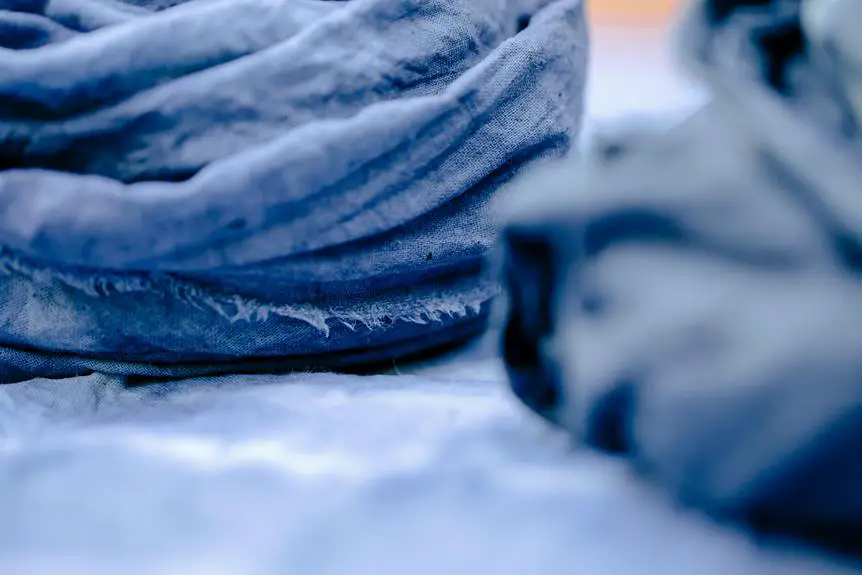If you're looking to add a personal touch to your sateen fabric, dyeing it can be a rewarding process. You'll want to start by washing the fabric to remove any finishes that might interfere with the dye. Once that's done, choosing the right dye is crucial for achieving the vibrant results you aim for. But the real magic happens during the dyeing process, where timing and technique play key roles. Curious about how to ensure your color sets perfectly and lasts? Let's explore the steps involved.
Table of Contents
Understanding Sateen Fabric
Sateen fabric, known for its smooth, lustrous finish, is a cotton weave that offers both elegance and durability. You'll appreciate its silky texture, which makes it a popular choice for various applications, from bedding to clothing. The weave consists of a satin weave structure, where more threads float on the surface, giving it that luxurious feel.
When you touch sateen, you'll notice it has a soft drape that enhances the flow of garments. Its sheen reflects light beautifully, adding a touch of sophistication to any project. Sateen is typically heavier than standard cotton, which contributes to its durability and makes it less prone to wrinkling.
However, it's essential to recognize that sateen can be sensitive to certain conditions. If you expose it to harsh chemicals or high temperatures, you risk damaging its fibers and finish. Knowing these characteristics will help you handle and care for sateen fabric properly.
Choosing the Right Dye
When choosing the right dye for your sateen fabric, you need to consider the type of fabric and its specific needs.
Different dye formulations can yield varying results, so understanding these options is crucial.
Plus, keeping colorfastness in mind will ensure your vibrant hues last through washes and wear.
Fabric Type Considerations
Choosing the right dye for your fabric is crucial to achieving vibrant, long-lasting colors. When dyeing sateen, it's essential to consider the fabric's composition. Sateen is typically made from cotton or a cotton blend, which means you'll want to select a dye specifically formulated for natural fibers.
If you're working with 100% cotton sateen, fiber reactive dyes are an excellent choice as they bond well with the fibers, yielding rich colors. On the other hand, if your fabric contains synthetic fibers, you'll need a dye that can effectively penetrate those materials.
Also, consider the dye's colorfastness. You want a dye that won't fade after a few washes, so look for options that specify high wash and light fastness. Always check the manufacturer's recommendations for the best results.
Additionally, keep in mind the desired outcome. If you want a subtle pastel shade, a different dye type may be more suitable than if you're aiming for bold, intense colors. By paying attention to these fabric type considerations, you'll set yourself up for success in your dyeing project.
Dye Formulations Explained
Understanding dye formulations is vital to ensure you select the right product for your sateen fabric. Different types of dyes react uniquely with fibers, and knowing which one suits your project can make all the difference. Here's a quick guide to help you choose the right dye:
- Fiber Reactive Dyes: These are perfect for cotton blends like sateen. They bond with the fabric, resulting in vibrant, long-lasting colors.
- All-Purpose Dyes: While versatile, they may not provide the same durability as fiber reactive dyes. If you're looking for quick results, they can be a good choice.
- Acid Dyes: If your sateen has silk or wool blends, acid dyes work well. They require heat to set, ensuring rich, deep colors.
- Natural Dyes: For an eco-friendly option, consider natural dyes derived from plants. They can produce beautiful hues but may require more effort to set and achieve consistent results.
Choosing the right dye can elevate your project and ensure that your sateen fabric looks stunning and stays vibrant over time.
Make sure to consider these factors before diving into your dyeing adventure!
Colorfastness Importance
Colorfastness is crucial because it determines how well your dye will hold up against washing, sunlight, and wear.
When you're choosing the right dye for your sateen fabric, you want to ensure it's colorfast to maintain the vibrancy of your project over time. Look for dyes specifically labeled as “colorfast” or those designed for the type of fabric you're working with.
For home dyeing, fiber reactive dyes are often a great choice for cotton sateen, as they bond well with the fabric and resist fading. If you're using synthetic sateen, opt for dyes formulated for polyester to achieve the best results.
Always check the manufacturer's recommendations regarding wash and light resistance, as they can vary significantly. Testing a small fabric swatch before committing to your entire project can save you from future disappointment.
Preparing the Fabric
Before you start dyeing your sateen fabric, make sure to wash it thoroughly to remove any finishes that could interfere with the dye. This step is crucial in ensuring an even and vibrant color.
Follow these simple steps to prepare your fabric properly:
- Gather Supplies: Collect your sateen fabric, detergent, a large basin, and water. Ensure your workspace is clean to prevent contamination.
- Wash the Fabric: Use a gentle detergent and wash the fabric in warm water. This will help to eliminate any sizing or finishes on the fabric that might resist dye.
- Rinse Thoroughly: After washing, rinse the fabric in cold water until the water runs clear. This step removes any remaining detergent, preparing the fabric for dye absorption.
- Dry the Fabric: Lay the fabric flat or hang it to dry completely. Avoid using a dryer, as heat can set any remaining finishes.
The Dyeing Process
Now that you've prepared your sateen fabric, it's time to focus on the dyeing process.
You'll want to carefully apply the dye to achieve the desired color and finish.
Let's break down the steps to ensure you get the best results.
Preparing the Fabric
To achieve the best results when dyeing sateen fabric, you'll want to start by thoroughly washing it to remove any finishes that could interfere with the dye absorption. This step is crucial for ensuring even color application.
Here's how to prepare your fabric:
- Gather Your Materials: Collect a mild detergent, a large basin or washing machine, and warm water to wash the fabric effectively.
- Wash the Fabric: Use the mild detergent in warm water to wash the sateen. This will help remove any sizing or chemicals that may be present.
- Rinse Thoroughly: After washing, rinse the fabric in cool water until the water runs clear. This ensures all detergent residues are removed.
- Dry the Fabric: Lay the fabric flat or hang it to dry. Make sure it's completely dry before proceeding to the dyeing process.
Applying the Dye
Carefully mix your chosen dye with warm water in a large container, ensuring it's well-dissolved before adding the fabric.
Once the dye is ready, submerge your pre-washed sateen fabric into the solution. Make sure the fabric is fully immersed to achieve an even color. Stir the fabric gently but consistently to avoid any patchiness.
Keep an eye on the clock; the dyeing time can vary based on the dye type and desired color intensity. Typically, you'll want to let it soak for about 30 minutes to an hour. For deeper shades, consider extending the time, but check periodically to avoid over-saturation.
After the desired color is achieved, remove the fabric from the dye bath and rinse it under cold water. This helps to wash out any excess dye. Continue rinsing until the water runs clear, indicating that the dye has set properly.
Setting the Color
Setting the color in sateen fabric is crucial for ensuring that your vibrant hues stay bright and don't fade after washing. To achieve this, you'll need to use a color fixative that helps bond the dye to the fabric fibers. Here's how to effectively set the color:
- Choose the Right Fixative: Look for a fixative that's compatible with the dye you used. Brands vary, so read the labels carefully.
- Prepare the Solution: Dissolve the fixative in water according to the manufacturer's instructions. Make sure the solution is well-mixed and evenly distributed.
- Soak the Fabric: Submerge your dyed sateen fabric in the fixative solution. Let it soak for the recommended time, usually around 20-30 minutes, to ensure complete saturation.
- Rinse Thoroughly: After soaking, rinse the fabric under cool water until the water runs clear. This step removes any excess fixative and helps lock in the color.
Once you've completed these steps, you'll significantly improve the longevity of your fabric's color. Enjoy the vibrant results of your dyeing project!
Care and Maintenance Tips
Now that you've set the color in your dyed sateen fabric, it's important to know how to care for it to keep those vibrant hues looking fresh.
First, always wash your dyed sateen in cold water using a mild detergent. Hot water can cause the colors to fade, so avoid it at all costs. If you can, hand wash your fabric to minimize agitation, which helps preserve the dye.
When it comes to drying, skip the dryer. Instead, hang your fabric to air dry in a shaded area to prevent sun exposure from fading the colors. If you need to iron, do it on a low setting while the fabric is slightly damp to avoid scorching.
For long-term storage, keep your dyed sateen away from direct sunlight and in a cool, dry place. Fold it neatly to prevent creasing.
If you notice any stains, treat them immediately with a gentle stain remover, but always test it on a hidden area first to ensure it won't affect the color.
Frequently Asked Questions
Can I Use Natural Dyes on Sateen Fabric?
Yes, you can use natural dyes on sateen fabric. Just make sure to prepare the fabric properly and choose the right mordant to achieve vibrant colors. Experiment a bit to see what works best for you!
How Do I Fix Dye Mistakes on Sateen?
If you've made dye mistakes, don't worry! You can try using a color remover or bleach, but test on a small area first. Re-dyeing might also help achieve the desired shade and fix imperfections.
Is It Safe to Dye Sateen at Home?
Yes, it's generally safe to dye sateen at home, as long as you follow proper safety precautions. Use well-ventilated areas, wear gloves, and handle dyes carefully to avoid stains and any potential hazards.
What Tools Do I Need for Dyeing Sateen?
To dye sateen, you'll need fabric dye, a large pot or bucket, stirring stick, gloves, and a measuring cup. It's also helpful to have salt or vinegar, depending on the dye type you choose.
How Long Will the Dyed Color Last on Sateen?
The longevity of the dyed color on sateen depends on factors like dye type, fabric care, and exposure to sunlight. With proper care, you can expect vibrant colors to last several washes before fading.
- How Does Ring Spun Cotton Affect Garment Fit and Shape Retention? - August 13, 2024
- What Are the Challenges in Producing Ring Spun Cotton? - August 13, 2024
- Is Ring Spun Cotton Suitable for Plus-Size Clothing? - August 13, 2024







